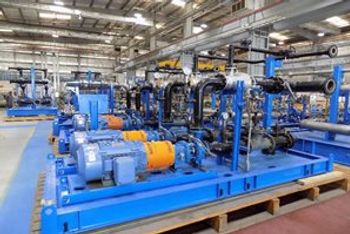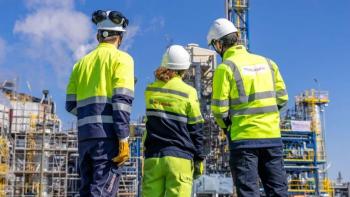
TPS 2025: Siemens Energy’s New Rotor Tech Tackles Hydrogen Compression Challenge
Key Takeaways
- Siemens Energy's single-piece rotor design improves hydrogen compression efficiency by eliminating stress concentrations, allowing higher tip speeds and fewer impeller stages.
- The rotor, made from raw forged steel, integrates four compressor stages and has been tested for stability, meeting API 617 requirements with no abnormal phenomena.
The company’s compressor testing suggested that single-piece rotor manufacturing enables higher tip speeds, which maintains an optimal pressure ratio for compressing hydrogen.
Hydrogen is poised to play a central role in the global energy transition, but safely and efficiently compressing the lightest of molecules remains a technical challenge. Siemens Energy has taken a major step toward addressing that challenge by designing and testing a single-piece rotor for a hydrogen compressor, demonstrating improved efficiency, reliability, and design flexibility in a closed-loop test facility.
At the 2025 Turbomachinery & Pump Symposia,
Hydrogen Compression Challenges
Hydrogen’s low molecular weight makes it difficult to compress efficiently. Traditional compressors rely on multi-stage designs with complex seals and joints that can be prone to stress and wear. High impeller tip speeds are critical to compressing gases like hydrogen because they help maintain the required pressure ratio. But in conventional rotors, speed is limited by stress concentrations at the bore, joints, or blade attachments.
The single-piece rotor design overcomes those limitations. By eliminating joints, hollow bores, and blade attachments, the rotor avoids the stress concentrations that typically limit tip speed. The result is a rotor capable of higher tip speeds, greater pressure ratios, and fewer impeller stages, making the machine more compact and efficient.
Inside the Single-Piece Rotor Design
Siemens Energy’s prototype uses raw forged steel, heat-treated and machined on a five-axis mill. It integrates four compressor stages of the inducer type with unshrouded impellers, designed to run at up to 28,540 rpm. The rotor assembly underwent overspeed and high-speed balancing tests, recording low amplitudes of just 0.16 mil (4 microns) in balance machines.
Supporting systems were also engineered to ensure stability and monitoring. The design incorporates:
- Non-damper journal bearings with temperature sensors
- Tandem seals and axial probes
- Thrust bearing load cells individually calibrated
- Diaphragm coupling to reduce moment load
During testing, bearing pad temperatures peaked around 165 °F, with no abnormal vibration, rubbing, or oil pressure fluctuations observed. The design met all API 617 stability requirements and revealed no unusual phenomena attributed to the single-piece rotor construction.
Testing at Closed-Loop Facility
Performance was validated at Siemens Energy’s closed-loop test facility, where hydrogen, helium, and nitrogen were circulated under controlled conditions. The facility is equipped with more than 50 instruments to measure process data, enabling precise correlation between predicted and observed performance.
The prototype compressor, rated for 4-MW operation, was driven by a 2,000-HP, four-pole motor with a variable frequency drive. Testing covered 65 - 105% of nominal operating speeds, with helium runs at 84% of hydrogen test conditions. Results showed:
- Slightly higher efficiency and larger stability margins than anticipated
- Balance piston leakage measurements that closely matched predictions
- Overall test uncertainty of less than 1%
Mechanical integrity was proven across more than 30 tests, including full-speed operation and power split trials with two-stage parallel shaft gearboxes. Importantly, the hydrogen prototype passed with stricter-than-API 617 power tolerances.
Efficiency, Reliability, and Repairability
The testing confirmed that Siemens Energy’s single-piece rotor not only delivers higher efficiency but also simplifies reliability management. Because the rotor is machined as one body, stress distribution is more uniform, reducing failure risks at joints or welds. At the same time, the design remains repairable. Engineers developed a weld-repair solution that allows restoration without full replacement, which would otherwise be costlier. In fact, machining a replacement single-piece rotor can be done in about the same time as repairing an impeller on a conventional unit.
The technology also demonstrated low vibration amplitudes, no radial sub-synchronous vibration, and steady-state amplitudes within API standards. The thrust bearing showed minor pad flutter at low load and high speed, but no evidence of instability or performance loss.
Implications for Hydrogen Infrastructure
The hydrogen economy will require compressors that can handle high flows at high efficiency, often in multi-body or parallel-train configurations. Siemens Energy’s single-piece rotor can be integrated into single or multi-body trains, offering redundancy, reliability, and capacity control while managing equipment count.
With its ability to support higher impeller tip speeds, the design may also extend beyond the current four-stage limit. Early data suggest the rotor can enable compressors with more than four impellers, further increasing throughput without sacrificing stability.
A Step Forward for Energy Transition
By proving the viability of a single-piece rotor in hydrogen compression, Siemens Energy has opened new possibilities for cleaner, more efficient gas handling. The results—steady performance, measurable efficiency gains, and a larger stability margin—indicate that this innovation can play a critical role in scaling up hydrogen infrastructure.
As global demand for low-carbon hydrogen grows, equipment reliability and efficiency will become decisive factors. Siemens Energy’s breakthrough shows that even the smallest design details—down to how a rotor is machined—can shape the future of energy. With hydrogen expected to play a central role in decarbonization, technologies like this one may prove essential in bridging the gap between today’s technology and tomorrow’s energy systems.
Check out more from TPS 2025, with coverage on
Newsletter
Power your knowledge with the latest in turbine technology, engineering advances, and energy solutions—subscribe to Turbomachinery International today.





